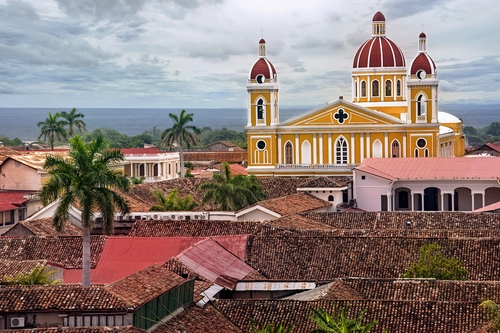Nicaragua offers unexpected treasures
Seeking an adventure somewhere that wouldn’t be overwhelmingly packed on a holiday weekend, I settled on Costa Rica’s northerly neighbor, Nicaragua. I figured it was close enough to the popular and tourist friendly Central American country to offer some spectacular sights.
Upon landing at the airport in Managua, my friends and I were greeted by the private tour company we hired and made a couple of stops in the colorful, but rather deserted, capital before heading up a mountainside to the Masaya Volcano.
Off the van, we walked toward the crowd to a lookout point that revealed a massive, active volcanic crater. The caldera was deeper than the eye could see, so far down I could not catch a glimpse of lava, only reddish smoke ascending into plumes of brown and gray. The marvelous volcano, only half an hour from Managua, I heard was even more mystifying at night.
Our destination was the Pacific coastal town of San Juan del Sur, but we made a stop along the way at the Islets of Granada and took a peaceful boat ride. The small islands had houses that I imagined belonged to wealthy Nicaraguans, and big trees with monkeys residing. We passed by a boat with two men merrily net fishing, a pleasant reminder of the joys of a simple life.
In the city of Granada, we walked through blocks of Spanish colonial buildings and admired the yellow-and-white neoclassical facade of the Our Lady of the Assumption Cathedral. An hour-and-a-half ride south brought us to San Juan del Sur by evening.
After checking into Hotel La Estación, we walked across the street to Restaurante El Buen Gusto on the beach for dinner. A large fish and lobster tail duo smothered in clams and a creamy sauce cost a fraction of what it would back in California. I paired it with a refreshing, bright purple dragon fruit margarita, then hopped along the restaurants and establishments on Paseo del Rey, the lively street that runs along the sand.
I found my excursion for the next day at an unlikely place, a hostel selling bus tickets to nearby points of interest.
Early the next morning, a friend and I took a 40-minute ride north to San Jorge, where we got tickets for an hour-long ferry to the island of Ometepe, which means, “two mountains.” At first, all we could see ahead of us on Lake Nicaragua was water. Then two peaks appeared in the distance, one taller than the other.
The two volcanoes joined by an isthmus formed the island we set out to explore. We docked at the largest village, Moyogalpa, got a paper map with the main attractions highlighted, and rented a motorbike to find them. The island has only one main road that, as far as we traveled, has space for only one vehicle in each direction.
There was no cell phone reception on the island and street signs were scarce, so we initially overshot the narrow paved path leading to Charco Verde, a large pond with an emerald hue coming from algae. We had a fresh fish lunch by the water then hit the road again for the second must-see stop, Ojo de Agua. The waterhole in the middle of the woods is no ordinary natural spring — it comes from the volcano Maderas. Taking a dip in the volcanic water, with a freshly machete-chopped coconut, I found paradise.
I could have stayed here forever, but I didn’t want to miss what surprise the last sight would bring. It was called Punta Jesus Maria. Getting there wasn’t the easiest — the road went from firm to loose dirt and soil. After passing some outdoor restaurants, we caught a glimpse of water. The further I walked, the narrower the land got, until water currents washed up from either side. To my friend, who stayed further back, I was walking on water.
The moment was all the more magical as the sun began to set. But we had to get back before the last ferry left us. On the boat, looking back at Ometepe as the sky turned bright orange and yellow, I felt I had found the treasure I was after in a trip to unexpected Nicaragua.rn

